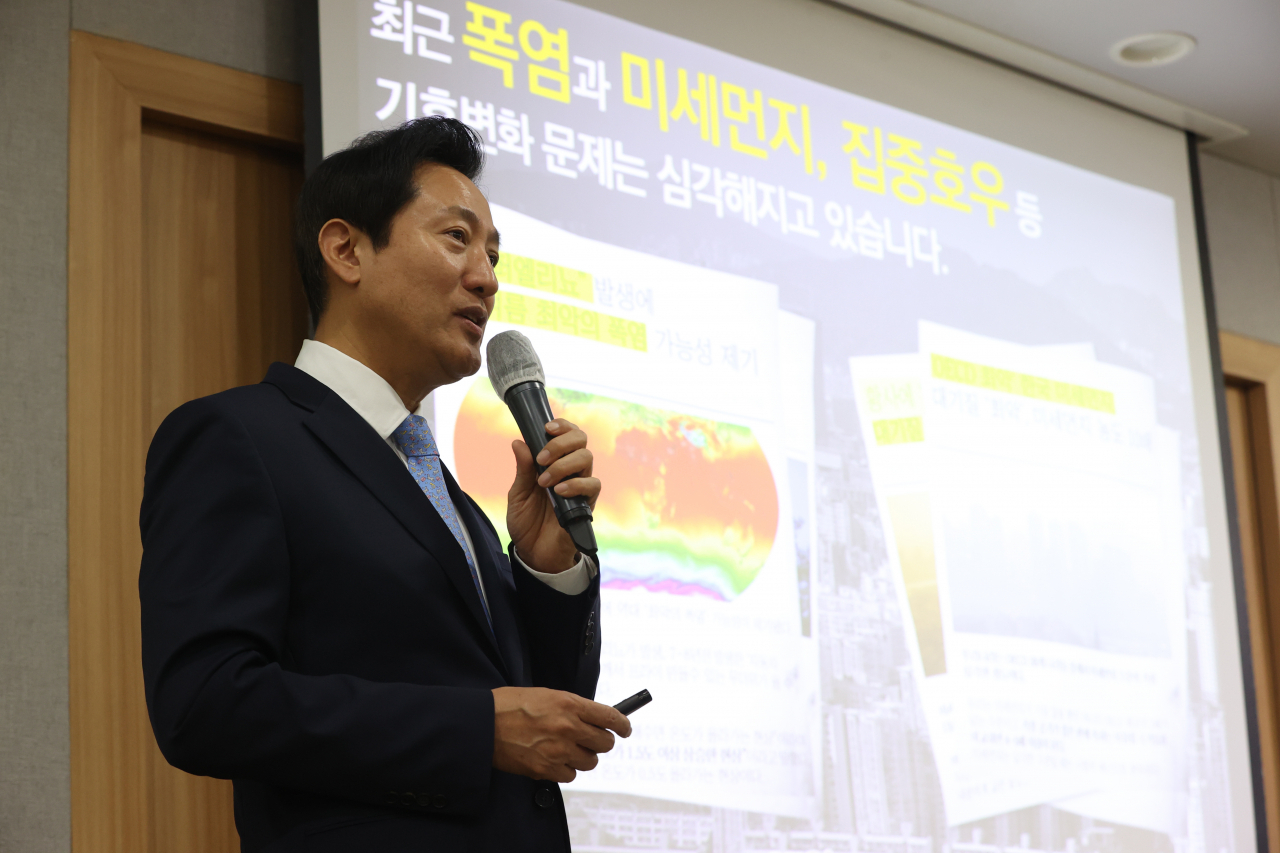
The Seoul Metropolitan Government said Wednesday it would inject 280 billion won ($212 million) to create new outdoor gardens in the capital city to reduce fine dust levels, lower average daily temperatures and increase citizens' access to nature.
Unveiling "Garden City Seoul," Mayor Oh Se-hoon said the city’s new initiative would pave the way for Seoulites to live a greener and healthier life, pointing out that nearly 60 percent of people in the capital reside in apartment complexes that don’t have direct access to gardens.
“Many people have to go out of Seoul on weekends to visit outdoor green spaces since there aren’t a lot of places offering citizens a space to rest and enjoy time with nature (in Seoul),” he said.
The project will create green spaces within a five-minute walking radius from people’s homes, which would reduce transportation costs, time and travel distances, he said.
The city government plans to make use of underused, open spaces across the city to create new gardens.
As part of the project, the metropolitan government will create a new garden at a previously abandoned site in Songhyeon-dong in Seoul’s Jongno-gu, where visitors can benefit from the green space and the natural attractions in the area. The Magok district, an underdeveloped area in western Seoul, will also become a leisure area where people can enjoy outdoor activities.
The city has also planned the “Greenway Project,” which is aimed at making pedestrian-friendly grassy walkways, rest facilities and landscape gardening along the Deoksugung stone-wall road next to Deoksugung Palace.
By 2026, the city government will build a 2.63-kilometer-long “Seoul Green Road” to link up the disconnected green spaces in Seoul.
Taking inspiration from the UK’s Chelsea Flower Show, also known as the Great Spring Show, held in May, and France’s garden show named the Chaumont Festival, Seoul hopes to turn the city into a cultural hub with a slew of garden shows.
For example, the week-long Seoul Garden Show will now welcome visitors for two months, and the city government will expand Haneul Park in the World Cup Park in western Seoul to attract more tourists.
The city government will also create 13 new walking trails and increase the number of walking paths connected to subway stations from the current 17 to 49.
Seoul is following in the footsteps of other places that have sought to become greener in face of growing climate risks.
The German city of Freiburg, for example, has the country’s largest communal forest, and covers 40 percent of the city. In Asia, Singapore has introduced the “Garden City” vision to blend nature with urban living.
“People (in Seoul) are suffering from climate change issues, such as the yellow dust from China, fine dust and torrid weather. But greenery can ease (these issues) and alleviate stress,” Oh said.


![[AtoZ into Korean mind] Humor in Korea: Navigating the line between what's funny and not](http://res.heraldm.com/phpwas/restmb_idxmake.php?idx=644&simg=/content/image/2024/04/22/20240422050642_0.jpg&u=)

![[Exclusive] Korean military set to ban iPhones over 'security' concerns](http://res.heraldm.com/phpwas/restmb_idxmake.php?idx=644&simg=/content/image/2024/04/23/20240423050599_0.jpg&u=20240423183955)

![[Herald Interview] Why Toss invited hackers to penetrate its system](http://res.heraldm.com/phpwas/restmb_idxmake.php?idx=644&simg=/content/image/2024/04/22/20240422050569_0.jpg&u=20240422150649)
![[Graphic News] 77% of young Koreans still financially dependent](http://res.heraldm.com/phpwas/restmb_idxmake.php?idx=644&simg=/content/image/2024/04/22/20240422050762_0.gif&u=)







![[Exclusive] Korean military to ban iPhones over security issues](http://res.heraldm.com/phpwas/restmb_idxmake.php?idx=652&simg=/content/image/2024/04/23/20240423050599_0.jpg&u=20240423183955)



![[Today’s K-pop] Ateez confirms US tour details](http://res.heraldm.com/phpwas/restmb_idxmake.php?idx=642&simg=/content/image/2024/04/23/20240423050700_0.jpg&u=)